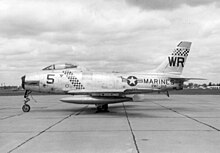VMFA-312
| Marine Fighter Attack Squadron 312 | |
|---|---|
F/A-18A/C/D Hornet |
Marine Fighter Attack Squadron 312 (VMFA-312) is a
History
World War II
Marine Fighter Squadron 312 (VMF-312) was commissioned on 1 June 1943, at Page Field,

In August 1943 the squadron was transferred to Marine Aircraft Group 32, 3rd Marine Aircraft Wing at the newly constructed Marine Corps Air Station Cherry Point, North Carolina. On 16 December 1943 the squadron received orders to prepare to move to the west coast of the United States beginning the first week of January 1944.[5] VMF-312 began movement to San Diego, California on 2 January 1944, eventually arriving at Miramar. The squadron departed MCAS Miramar on 28 February 1944 bound for Marine Corps Air Station Ewa, Hawaii. VMF-312 trained at MCAS Ewa for three months and then headed out for Espiritu Santo, New Hebrides[6] to become part of Marine Aircraft Group 11 (MAG-11), 2nd Marine Aircraft Wing (2nd MAW).[7]
Assigned to
Between September 1945 and February 1946 VMF-312 participated in the occupation force stationed on
1946-1950
Returning to the United States in February 1946, the squadron began operations at
The Korean War, 1950-1955
While aboard Bataan, the Checkerboards became the first piston engine squadron to shoot down a jet aircraft, when Captain Jesse Folmar shot down a
The 1960s through the 1990s


The Panthers were replaced with
During the Vietnam War, the "Checkerboards" performed the vital mission of training combat aircrews prior to their deployment to Southeast Asia.[17] In 1973, the squadron received the newer F-4J aircraft, with its much improved radar and avionics, as well as improved aerodynamic design.
In 1979, the Checkerboards became the first 2nd Marine Aircraft Wing fighter squadron to deploy to the
In 1993, VMFA-312 participated in Operation Provide Promise and Operation Deny Flight over Yugoslavia. They also flew missions over Iraq in support of Operation Southern Watch while operating from the Red Sea.
In March 1995, the squadron deployed once again with
In late August and September 1995, the "Checkerboards" conducted their first direct combat sorties since Vietnam in support of the United Nations resolutions in Operation Deliberate Force. NATO's decision to conduct immediate air strikes against Bosnian-Serb ammunition bunkers, communication and control facilities, and logistical storage buildings heavily tasked both the air wing and the Checkerboards.
The Checkerboards along with

Carrier Air Wing Three entered the North Persian Gulf and began Operation Southern Watch missions on 3 January 2001. On 20 January, a VMFA-312 jet destroyed an anti-aircraft artillery site, which was threatening coalition aircraft in Southern Iraq. On 16 February, five VMFA-312 aircraft participated in a large force strike against numerous targets in the vicinity of Baghdad.
Global War on Terror
The Checkerboards deployed aboard
The Checkerboards deployed several more times in support of
Notable former members
- Herbert J. Valentine – 6 kills
- William Farrell – 5 kills
- Phillip C. DeLong – 2 kills in Korea
- Robert R. Klingman - pilot with VMF-312 who was famous for destroying a Japanese reconnaissance plane using the propeller of his F4U Corsair during the Battle of Okinawa.[19]
- Kenneth L. Reusser
See also
- United States Marine Corps Aviation
- List of active United States Marine Corps aircraft squadrons
- List of inactive United States Marine Corps aircraft squadrons
Notes
- ^ Rottman 2002, pp. 443.
- ^ DeChant 1947, pp. 225.
- ^ Crowder 2000, pp. 114.
- ^ a b c Sambito 1978, pp. 1.
- ^ "3d Marine Aircraft Wing Operations Order 8-43" (PDF). United States Marine Corps. 16 December 1943. Retrieved 13 August 2020.
- ^ Sherrod 1952, pp. 467.
- ^ Sambito 1978, pp. 21.
- ^ Tillman 1979, pp. 143.
- ^ Shettle 2001, pp. 122.
- ^ Crowder 2000, pp. 117.
- ^ Crowder (2000), p.118.
- ^ Tillman 1979, pp. 167–68.
- ^ Crowder 2000, pp. 119.
- ^ "United States Marine Corps Muster Rolls - 1949-1953" (PDF). NARA. United States Marine Corps. p. 24. Retrieved 23 November 2023.
- ^ Tillman 1979, pp. 171–73.
- ^ Mersky 1983, pp. 194.
- ^ Crowder 2000, pp. 120.
- ^ "About".
- ^ "Marine Corps pilot Robert Klingman took down enemy using his propeller". We Are The Mighty. 23 February 2023. Retrieved 12 November 2023.
References
 This article incorporates public domain material from websites or documents of the United States Marine Corps.
This article incorporates public domain material from websites or documents of the United States Marine Corps.
- Bibliography
- Crowder, Michael J. (2000). United States Marine Corps Aviation Squadron Lineage, Insignia & History – Volume One – The Fighter Squadrons. Paducah, KY: Turner Publishing Company. ISBN 1-56311-926-9.
- DeChant, John A. (1947). Devilbirds: The Story of United States Marine Corps Aviation in World War II. Harper and Brothers Publishers.
- Mersky, Peter B. (1983). U.S. Marine Corps Aviation – 1912 to the Present. Nautical and Aviation Publishing Company of America. ISBN 0-933852-39-8.
- Rottman, Gordon L. (2002). U.S. Marine Corps World War II Order of Battle – Ground and Air Units in the Pacific War. ISBN 0313319065.
- Sherrod, Robert (1952). History of Marine Corps Aviation in World War II. Washington, D.C.: Combat Forces Press. ISBN 0-89201-048-7.
- Shettle, M. L. (2001). United States Marine Corps Air Stations of World War II. Bowersville, Georgia: Schaertel Publishing Co. ISBN 0-9643388-2-3.
- Tillman, Barrett (1979). Corsair: The F4U in World War II and Korea. Annapolis, MD: Naval Institute Press. ISBN 1-55750-994-8.
- Web
- Sambito, William J. (1978). A History of Marine Fighter Attack Squadron 312 (PDF). Washington, D.C.: United States Marine Corps.



